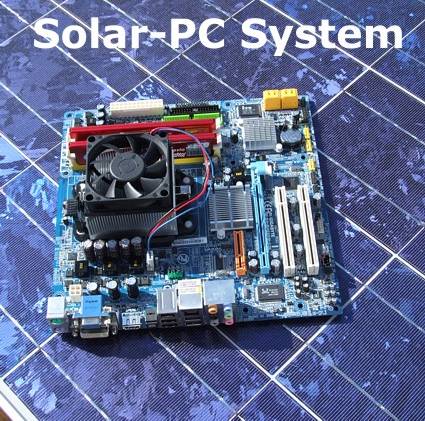Do-It-Yourself Solar-Powered PC: Hardware
A New Desktop PC Power Consumption World Record: 61 Watts
In the first installment of this series of articles we dealt with the technologies that permit solar energy to be collected and converted into electricity, to drive a solar-powered PC. In this second installment, we examine the components we chose to include in that PC, particularly in terms of how they meet our stringent requirements for minimal energy consumption. To that end, our Munich test labs made many measurements, which ultimately let us assemble a world-record-making desktop PC. The third and final installment in this series will provide a step-by-step description of the solar energy collection and storage system that made all this possible, so that interested readers can use it as a guide to build their own solar-powered PCs.
Our 61 watt solar PC, including the monitor, is constructed entirely from desktop components. Of course, we could have used a notebook, which already includes a monitor and a battery, and which seldom consumes more than 16 to 20 Volts. But the Tom's Hardware editorial staff elected to push the limits of technical feasibility. Our goal was to see what's possible and to provide instructions to others on how to make a desktop PC that runs only on solar energy, without any connection to the power grid whatsoever. This makes our PC location independent, and enables it to travel anywhere in the world where there's enough sunshine to meet its needs.
Of course, nobody is likely to do this for mobility's sake alone, simply because of the total weight of our rig, and the fact that solar panels don't really qualify as carry-on or even checkable luggage. It's probably best to treat this project as a kind of feasibility study, and as a stepping stone to other similar test builds. As is our practice at Tom's Hardware, we provide a wealth of information in this series of articles, not just to expose some fascinating technologies, but also to enable our readers to follow in the footsteps we document so carefully. In fact, it's not unthinkable that a system like this one might wind up in a remote mountain cabin or a hunting lodge in many places around the world.
Join our discussion on this topic
Get Tom's Hardware's best news and in-depth reviews, straight to your inbox.
Current page: A New Desktop PC Power Consumption World Record: 61 Watts
Next Page Power Delivery: Conventional A/C (120/230V) Or 16 Volts DC?Tom's Hardware is the leading destination for hardcore computer enthusiasts. We cover everything from processors to 3D printers, single-board computers, SSDs and high-end gaming rigs, empowering readers to make the most of the tech they love, keep up on the latest developments and buy the right gear. Our staff has more than 100 years of combined experience covering news, solving tech problems and reviewing components and systems.
-
Raigedas i bought this M2-ATX PSU (actually to of them). but i was unable to start it.Reply
1. first quick question: is it possible to start (for testing purposes) the PSU without connecting it to the computer? is it enough to short circuit J8 only to start?
2. docummentation is unclear about 10 (J6). it looks like J6 is purely for controlling stereo amplifier. but other place of the manual says "if J6 is cnnected to the motherboard". where to motherboard?
3. how should PSU be connected?
for testing i have taken 12V 7Ah lead acid battery fully charged.
connected battery "-" to J4.
battery "+" to J1.
J3: tried to leave not connected and tried to connect battery "+".
disconnected power switch cable from motherboard and connected it to J9.
connected J8 with motheboard (using little cable included in the package) where power switch was originally connected.
left J6 not connected.
J10 not connected (P0 mode). also tried P1 mode.
connected ATX and P4 (J2).
pressed power on my pc but nothing happened and no voltage on MOLEX cable.
could authors of the article (or maybe other owner of the PSU) describe how did they start the PSU?

